Renault KANGOO 2005 Owner Manual
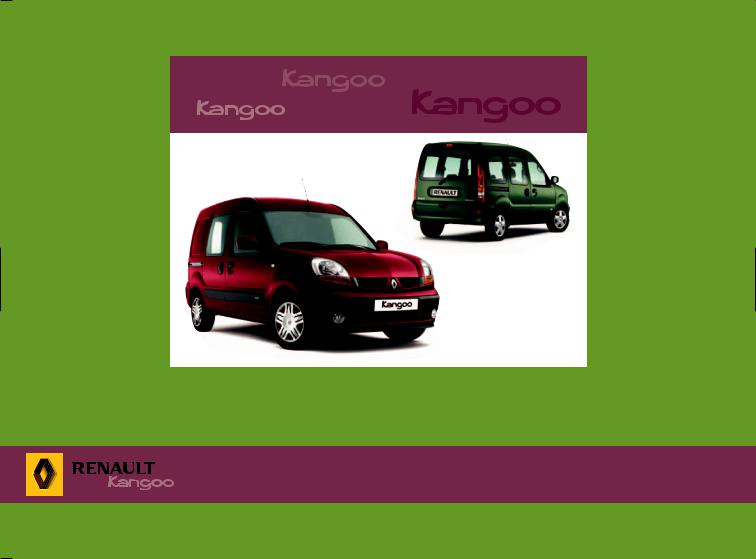
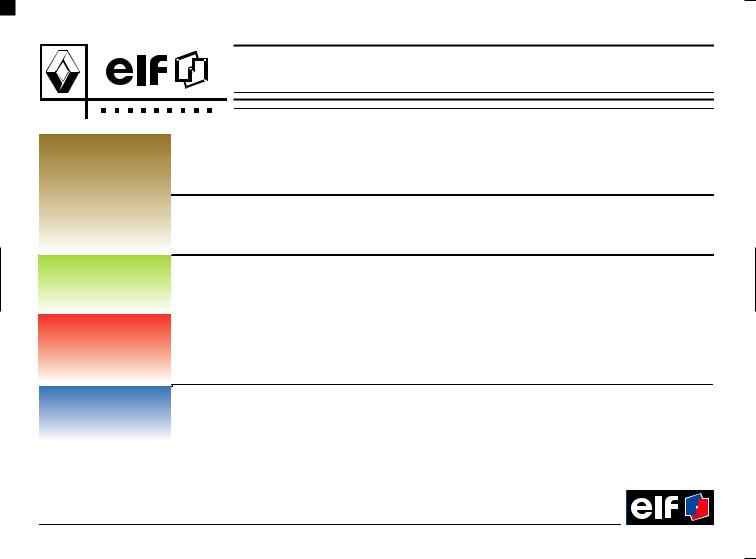



 has chosen ELF
has chosen ELF
For all engines |
ELF EXCELLIUM LDX 5W-40 |
ACEA A3 / B3 / B4 |
|
Optimum performance and maximum protection in the most severe conditions |
|
|
All types of driving |
|
|
ELF EVOLUTION SXR 5W-40 |
ACEA A3 / B3 / B4 |
|
Optimum performance |
|
|
All types of driving |
|
|
|
|
All types of petrol |
ELF EVOLUTION SXR 5W-30 |
ACEA A5 / B5 |
and LPG engines |
Fuel economy, engine protection and respect for the environment |
|
|
All types of driving |
|
|
|
|
For all engines |
ELF COMPETITION ST 10W-40 |
ACEA A3 / B3 / B4 |
|
ELF TURBO DIESEL 10W-40 |
ACEA B3 / B4 |
|
Other RENAULT approved lubricants for normal use |
|
|
|
|
Manual gearbox |
TRANSELF TRJ 75W-80 |
API GL5 |
Automatic gearbox |
RENAULTMATIC D3 Syn |
DEXRON III |
Kangoo 4×4 final drive |
TRANSELF UNIVERSAL 80W-90 |
API GL5 |
|
|
|
RENAULT recommends approved ELF lubricants.
When topping up or changing the oil, we recommend you use only the original lubricants.
Consult your RENAULT Dealer or visit the site www.lubricants.elf.com
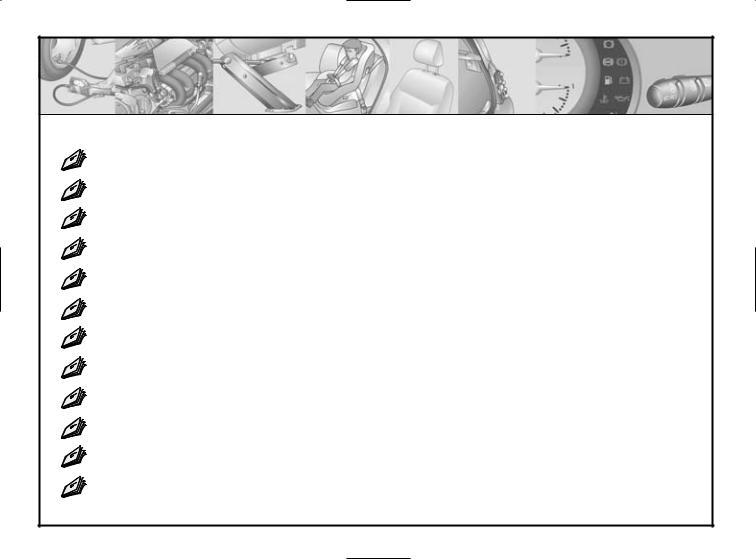
Quick overview
- Tyre pressures .............................................................................................................................. |
0.04 |
- Adjusting the seats and driver’s position .......................................................... |
1.22 1.25 |
- Child restraint devices ............................................................................................. |
1.34 1.45 |
- Warning lights ............................................................................................................. |
1.52 1.77 |
- De-icing/Demisting .................................................................................................................... |
1.80 |
- Visible and audible warning signals ................................................................................... |
1.81 |
- Running in, driving ................................................................................................... |
2.02 2.21 |
- Heating/air conditioning ......................................................................................... |
3.04 3.10 |
- Opening the bonnet ................................................................................................................... |
4.02 |
- Levels (engine oil, windscreen washer, etc.) ................................................... |
4.03 4.11 |
- Emergency spare wheel ........................................................................................... |
5.02 5.04 |
- Practical advice (changing the bulbs, fuses, repairs, |
|
operating faults) .......................................................................................................... |
5.02 5.40 |
0.02
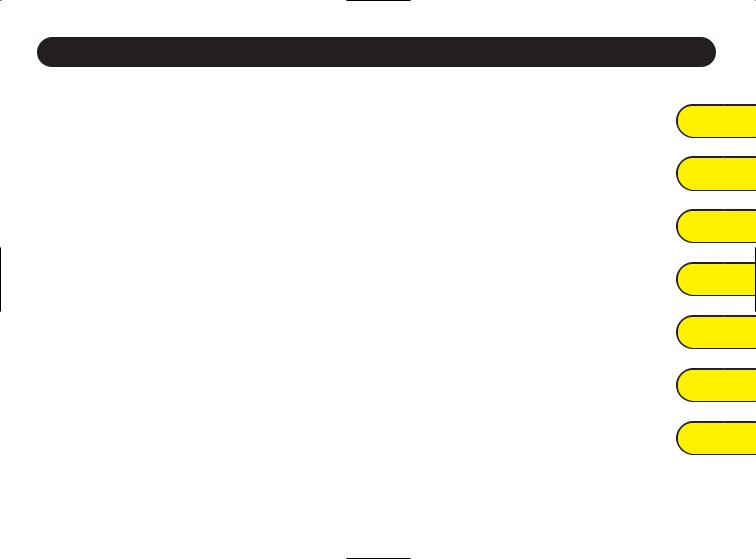
C O N T |
E N T S |
|
Sections |
Getting to know your vehicle |
................................................................ 1 |
Driving ................................................................................................................ |
2 |
Your comfort .................................................................................................. |
3 |
Maintenance ................................................................................................... |
4 |
Practical advice ............................................................................................ |
5 |
Technical specifications .......................................................................... |
6 |
Alphabetical index ...................................................................................... |
7 |
0.03

Tyre pressures when cold (in bar)
Tyre sizes |
165/70 R 14 C |
165/70 R 14 |
165/70 R 14 |
165/70 R 14 |
165/70 R 14 |
|
reinforced |
reinforced |
reinforced |
||||
|
|
|
||||
|
|
|
|
|
|
|
Normal use |
|
|
|
|
|
|
- Front |
2.6 |
2.4 |
2.5 |
2.2 |
2.3 |
|
- Rear |
3.4 |
3.0 |
3.2 |
2.2 |
2.3 |
|
|
|
|
|
|
|
|
Full load use and/or motorway |
|
|
|
|
|
|
driving (1) |
|
|
|
|
|
|
- Front |
2.6 |
2.4 |
2.5 |
2.4 |
2.4 |
|
- Rear |
3.4 |
3.0 |
3.2 |
2.6 |
2.6 |
|
|
|
|
|
|
|
|
Emergency spare wheel |
|
|
|
|
|
|
- identical to other 4 wheels |
3.4 |
– |
3.2 |
2.6 |
2.6 |
|
- for temporary use |
– |
2.9 (13") |
– |
– |
– |
|
|
|
|
|
|
|
|
Wheel sizes |
5.5 J 14 |
5.5 J 14 |
5.5 J 14 |
5.5 J 14 |
5.5 J 14 |
|
|
|
|
|
|
|
Tyre safety and use of chains
Refer to the information on tyres in section 5 for advice on tyre maintenance and, depending on the version, the use of chains.
(1)Special note concerning vehicles used at full load (maximum permissible all-up weight) and towing a trailer
The maximum speed must be limited to 60 mph (100 km/h) and the tyre pressure increased by 0.2 bar. Refer to the information on weights in section 6 for more details.
0.04
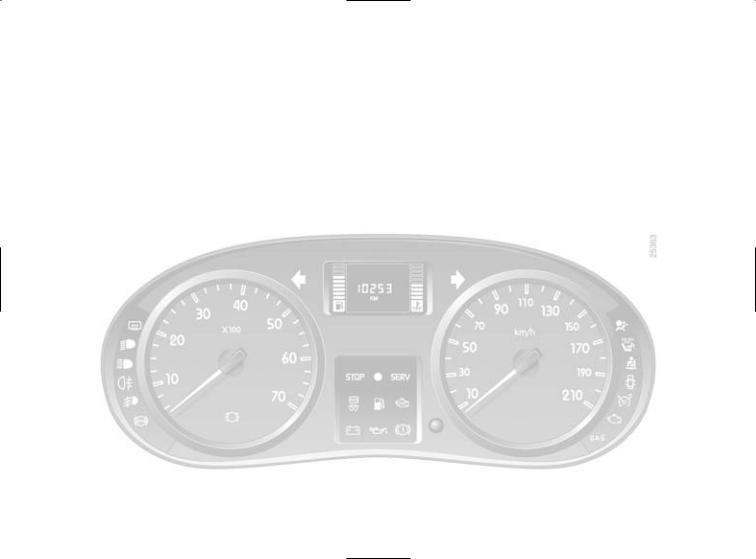
Section 1: Getting to know your vehicle
Keys ........................................................................................................................................................................... |
1.02 |
|
Radio frequency remote control unit .................................................................................................. |
|
1.03 1.06 |
Doors .......................................................................................................................................................... |
|
1.07 1.13 |
Renault Anti-Intruder Device (RAID) ................................................................................................................. |
1.14 |
|
Engine immobiliser ................................................................................................................................... |
1.15 - 1.16 |
|
Headrests ..................................................................................................................................................... |
1.17 - 1.18 |
|
Roof flap ....................................................................................................................................................... |
1.19 - 1.20 |
|
Partition .................................................................................................................................................................... |
1.21 |
|
Front seats ................................................................................................................................................................ |
1.22 |
|
Rear view mirrors ................................................................................................................................................... |
1.23 |
|
Seat belts .................................................................................................................................................... |
|
1.24 1.27 |
Restraint systems in addition to front seat belts ............................................................................... |
|
1.28 1.33 |
Side protection devices ......................................................................................................................................... |
1.32 |
|
Child safety ............................................................................................................................................... |
|
1.34 1.45 |
Driver’s position ....................................................................................................................................... |
|
1.46 1.51 |
Instrument panel ...................................................................................................................................... |
|
1.52 1.77 |
Clock ............................................................................................................................................................. |
1.78 - 1.79 |
|
Rear screen and windscreen de-icing and demisting ..................................................................................... |
1.80 |
|
Audible and visual warnings ............................................................................................................................... |
1.81 |
|
Headlight beam adjustment ................................................................................................................................. |
|
1.82 |
|
||
External lighting and signals ................................................................................................................... |
|
1.83 - 1.84 |
Screen wash/wipe ...................................................................................................................................... |
|
1.85 - 1.86 |
Fuel tank ...................................................................................................................................................... |
|
1.87 - 1.88 |
|
||
1.01
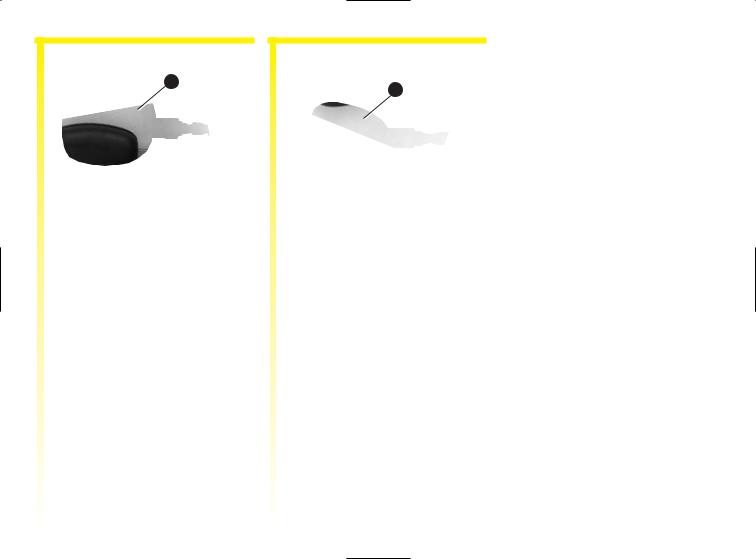
KEYS
1
2
1 Coded key for ignition switch, |
2 Key for ignition switch, doors and |
doors and fuel filler cap. |
fuel filler cap. |
1.02
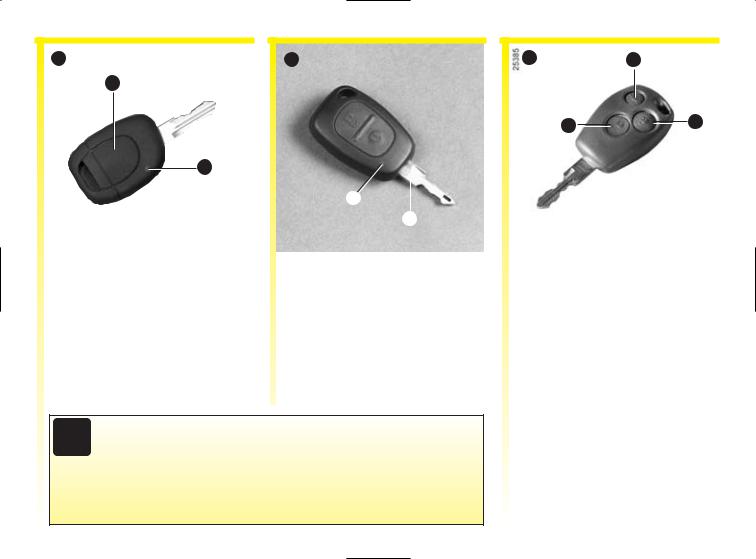
RADIO FREQUENCY REMOTE CONTROL: general information
A |
B |
1
2
|
|
|
|
|
|
|
|
|
|
|
|
|
4 |
|
|
|
|
|
|
|
|
|
|
|
|
|
|
|
|
|
|
|
3 |
|
|
Radio frequency remote control A |
Radio frequency remote control B |
|||||||
1 |
Key for ignition switch, doors and |
3 |
Key for ignition switch, doors and |
|||||
|
fuel filler cap. |
|
fuel filler cap. |
|||||
2 |
Battery warning light. |
4 |
Battery warning light. |
|||||
Driver’s responsibility
 Never leave the vehicle unattended with the key in the ignition if there is a child (or animal) in the vehicle. With the key in the ignition, he or she could start the engine or operate electrical equipment such as the electric windows and there is a risk that the child may be injured by trapping his or her neck, arm, hand, etc. Risk of serious
Never leave the vehicle unattended with the key in the ignition if there is a child (or animal) in the vehicle. With the key in the ignition, he or she could start the engine or operate electrical equipment such as the electric windows and there is a risk that the child may be injured by trapping his or her neck, arm, hand, etc. Risk of serious
injury.
C |
7 |
5 |
6 |
Radio frequency remote control C
5 Unlocking the front doors and, depending on the vehicle, sliding side doors.
Unlocking the doors and luggage compartment.
6 Locking the doors and luggage compartment.
7 Locking/Unlocking the luggage compartment and, depending on the vehicle, sliding side doors.
1.03
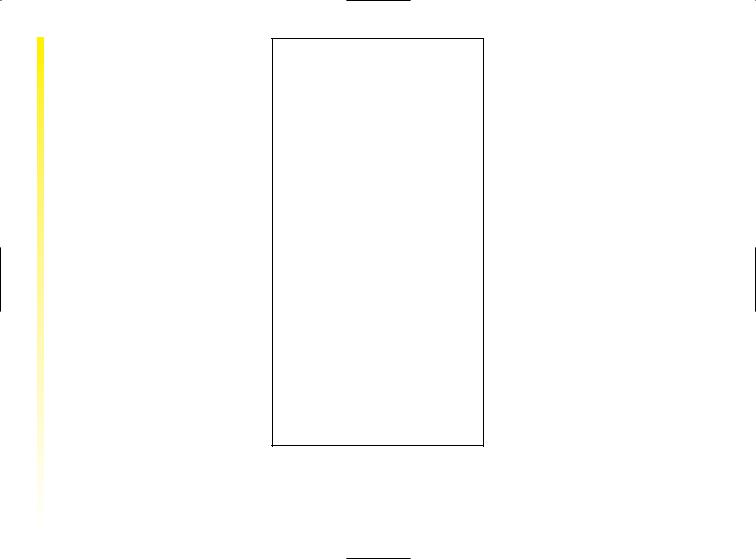
RADIO FREQUENCY REMOTE CONTROL UNIT: general information (continued)
Remote control unit operating range
This varies according to the environment: therefore take care when handling the remote control that you do not inadvertently lock or unlock the doors.
Note: on certain vehicles, if a door is not opened within approximately 30 seconds of the door being unlocked by remote control, the doors will lock again automatically.
Interference
Interference may be caused to the operation of the remote control by factors in the immediate vicinity (external installations or the use of equipment operating on the same frequency as the remote control).
If you lose your keys or remote control unit, or need another set, contact your RENAULT Dealer.
-If a remote control unit is replaced, it will be necessary to take the vehicle to your RENAULT Dealer because both the vehicle and the remote control are needed to initialise the system.
-Depending on the vehicle, you have the option of using up to four remote control units.
Contact your RENAULT Dealer.
If the remote control unit will not operate:
-Make sure that the batteries are always in good condition; they have a service life of approximately two years.
See Radio frequency remote control: batteries in Section 5 for the battery replacement procedure.
1.04
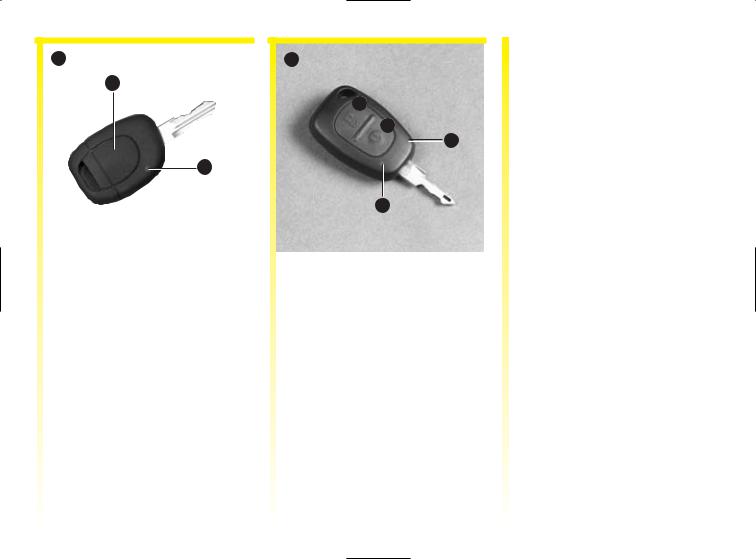
RADIO FREQUENCY REMOTE CONTROL: use
A
1
2
Remote control units A and B are used to lock and unlock the doors.
They are supplied by a battery which must be replaced when the battery warning light 2 or 4 no longer lights up (see Remote control locking: batteries).
B
E
D
3
4
Locking/unlocking the doors
Remote control unit A
Press the remote control for approximately one second to lock or unlock the doors. (indicator light 2 will come on.)
Remote control unit B
Press the remote control unit for approximately one second (indicator light 4 comes on) to lock (side D) or to unlock (side E).
The side mounted indicators and hazard warning lights flash twice to indicate that the doors have been locked.
Note: depending on the vehicle, if either a door or the luggage compartment is open or not properly closed, the hazard warning lights will not flash.
The hazard warning lights and side mounted indicators flash once to indicate unlocking.
1.05
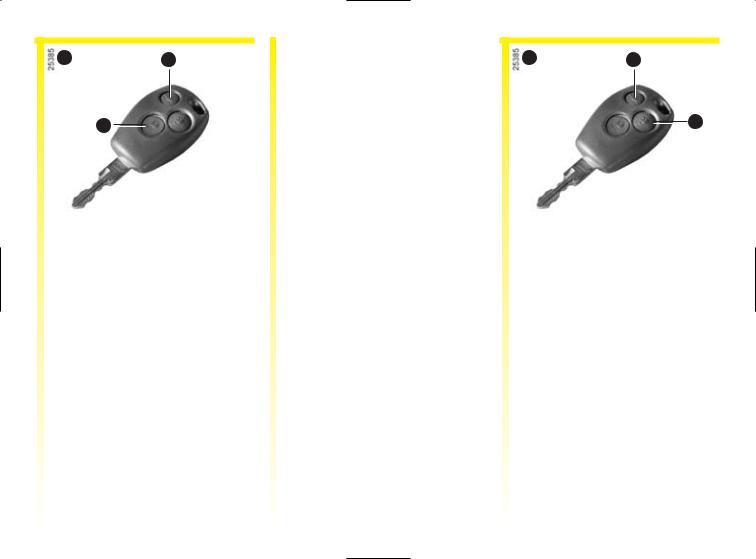
RADIO FREQUENCY REMOTE CONTROL UNIT: use (continued)
C |
6 |
5
Remote control unit C locks and unlocks the doors.
It is powered by a battery which must be replaced (see Radio frequency remote control: battery in Section 5).
Unlocking the doors
A short press on button 5 unlocks the front doors and, depending on the vehicle, the sliding side doors.
Pressing and holding button 5 unlocks all the doors and luggage compartment.
A short press on button 6 unlocks the luggage compartment and, depending on the vehicle, the sliding side doors.
The hazard warning lights and side mounted indicators flash once to indicate unlocking.
Special notes (for some countries):
-pressing button 5 unlocks the driver’s door only.
-pressing and holding button 5 unlocks all the doors and the luggage compartment.
C |
6 |
7
Locking the doors
Pressing button 7 locks all the doors and luggage compartment.
Pressing button 6 locks/unlocks the luggage compartment and, depending on the vehicle, the sliding side doors.
The side indicators and hazard warning lights flash twice to indicate that the doors have been locked.
1.06

DOORS
1
2
3
Front door
Opening manually from the outside
Unlock using the key after inserting it fully into one of the front door locks 1. Place your hand behind handle 2 and pull it towards you.
Opening from the inside
Move handle 4 or 6.
4
Sliding side door
Opening manually from the outside
Unlock the door using a key in the same way as a front door, place your hand behind handle 3 and slide the door towards the rear of the vehicle until it locks in position.
Closing from the inside
Use handle 5 to close the door completely.
Check that it is correctly locked.
Recommendations for the sliding side door (left or right-hand side)
Appropriate precautions must be taken when opening or closing the sliding door, as is the case for any of the vehicle’s doors.
-Check that the door will not come into contact with any person, part of your body, animal or object.
-Only use the handles on the inside and outside of the door to operate it.
-Take care when opening and closing the door.
-Take particular care when the vehicle is parked on a slope: open the door with care until it is fully open and latches into its locking position.
-Before moving off, always ensure that the door is properly closed.
-Do not use the lower support as a step.
1.07
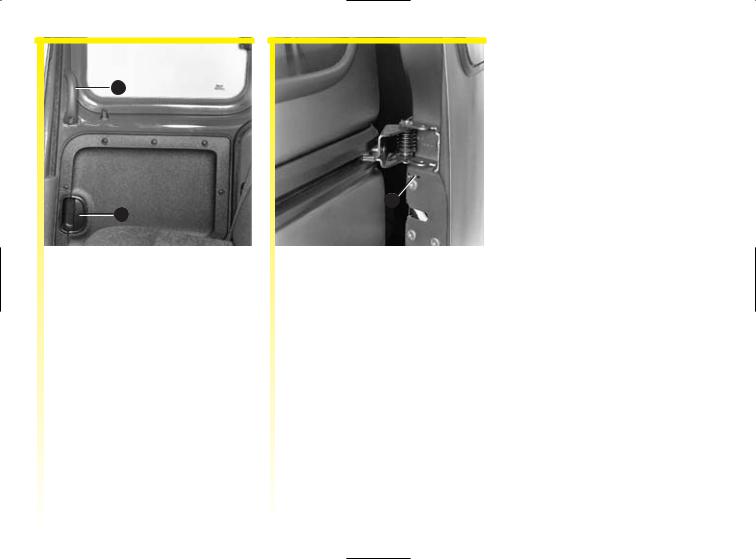
DOORS (continued)
5
6
Lights-on reminder buzzer
If you have left the lights switched on after turning off the ignition, a warning buzzer will sound when a door is opened (to prevent discharge of the battery, etc.).
oThis warning light
indicates that a door is not shut properly.
7
Childproof locks
To prevent the side door from being opened from the inside, move lever 7 and check from inside the vehicle that it is locked correctly.
1.08

DOORS (continued)
Locking manually from the outside
First close the small door and then close the large door.
Door stays 3 will lock into their locations automatically.
1 |
2 |
3
Rear hinged doors
Opening manually from the outside
Unlock using the same key as for the front doors.
Place your hand behind handle 1 and pull it towards you.
To open the rear doors completely
To open the doors fully, move catch 2, open the door fully so that stay 3 is released.
Proceed in the same way for the other door.
1.09

DOORS (continued)
 4
4
Rear hinged doors (continued) Opening from the inside
The small door can be opened from inside the vehicle by turning handle 4 downwards.
If the vehicle is parked on the hard shoulder with luggage compartment door open, the rear lights
may be obscured. You should make other road users aware of the presence of your vehicle by using a warning triangle or other equipment specified by the road traffic regulations of the country concerned.
5
6
7
Tailgate
Opening manually from the outside
To unlock, insert the ignition key into lock 5.
Place your hand behind handle 6 and lift to open.
Close the luggage compartment door by shutting it firmly but carefully. Do not pull on the hydraulic struts to do this.
Make sure it is correctly locked in position by trying to lift it at 7.
1.10
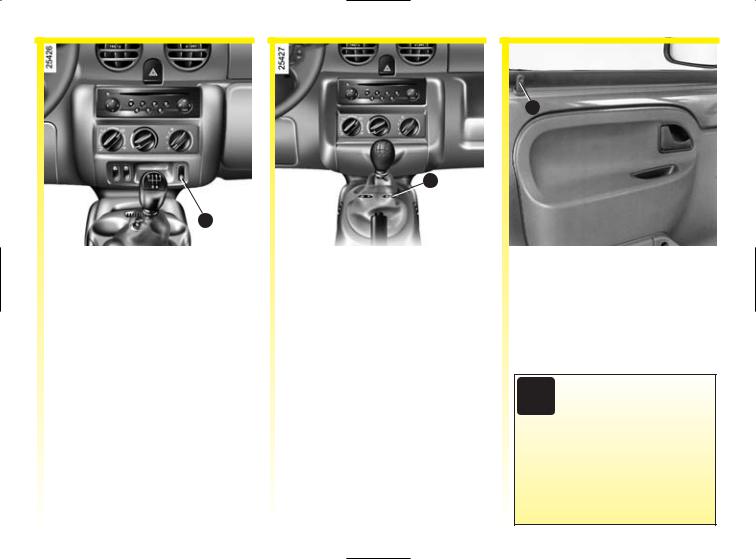
LOCKING THE DOORS
|
|
1 |
1 |
|
|
Electric central locking |
|
|
This enables all the doors to be |
Check that |
buttons 2 are pressed |
locked simultaneously. |
down fully. |
|
Lock by pressing the opposite side to the figurine on switch 1.
2
Manual locking
Front door
Use the key if outside or, if inside the vehicle, press down button 2 fully when the door is closed.
If you decide to keep the doors locked when you are driving, remember that it may be more
difficult for those assisting you to gain access to the passenger compartment in the event of an emergency.
1.11
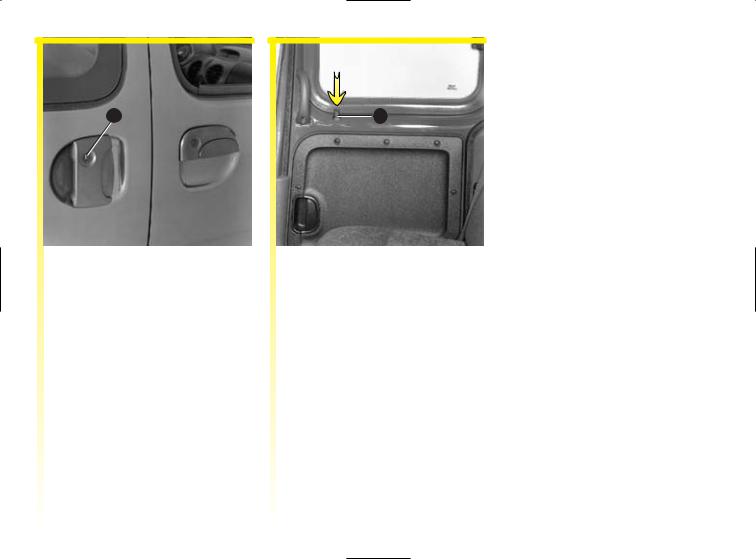
LOCKING THE DOORS (continued)
3 |
4 |
Sliding side door (right-hand side)
From outside, insert the key fully into lock 3 and lock the door.
From inside, fully depress button 4, with the door closed.
1.12

LOCKING THE DOORS (continued)
Second sliding side door (located on the fuel filler cap side).
This door does not have a lock on the outside. It is locked or unlocked from outside the vehicle using the remote control (at the same time as the other doors) or from the inside by moving the locking button (same for the other side door).
Opening and closing operations are the same as for the other sliding side door.
Special information when filling with fuel:
Depending on the vehicle, when the fuel filler cap is removed during refuelling:
-the doors lock then unlock immediately, except for the side door which remains locked,
-only the side door locks.
This is to prevent the door from striking against the filler nozzle during refuelling.
When the fuel tank has been filled, refit the cap. The locking button is operational again.
For vehicles without remote control locking, the door is always locked and it is therefore possible to unlock it from the inside.
Note: if the door was open before the fuel filler cap was removed, it will not lock.
To ensure that it does not collide with the fuel pump filler nozzle while the fuel tank is being filled, close the door, taking precautions to ensure that no one is injured. It will then lock automatically.
1.13
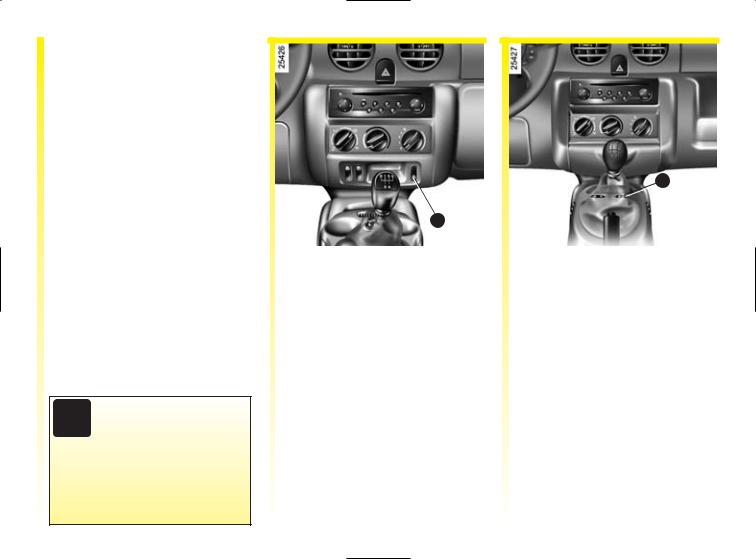
RENAULT ANTI-INTRUDER DEVICE (RAID)
You must first decide if you want to activate this function.
To activate
With the ignition on, press button 1 on the locking side (opposite the symbol) for approximately 5 seconds, until you hear the beep.
To deactivate
With the ignition on, press button 1 on the locking side (opposite the symbol) for approximately 5 seconds, until you hear the beep.
Operating principle
When the vehicle moves off, the system automatically locks the doors as soon as a speed of 5 mph (8 km/h) is reached.
If you decide to keep the doors locked when you are driving, remember that it may be more
difficult for those assisting you to gain access to your vehicle in the event of an emergency.
1
Depending on the vehicle, pressing unlocking button 1 or opening a front door unlocks:
-all the doors and the luggage compartment;
-the front doors and the sliding side doors;
-the front doors.
Note: if a rear door is opened, it will automatically lock again when the vehicle reaches a speed of approximately 5 mph (8 km/h).
1
Operating faults
If you note that the system is not operating correctly (automatic locking does not take place), first check that all the doors have been properly closed. If they are closed correctly, consult your RENAULT Dealer.
Also make sure that locking has not accidentally been deactivated.
If this is the case, switch the ignition off and on again and reactivate the system as described above.
1.14
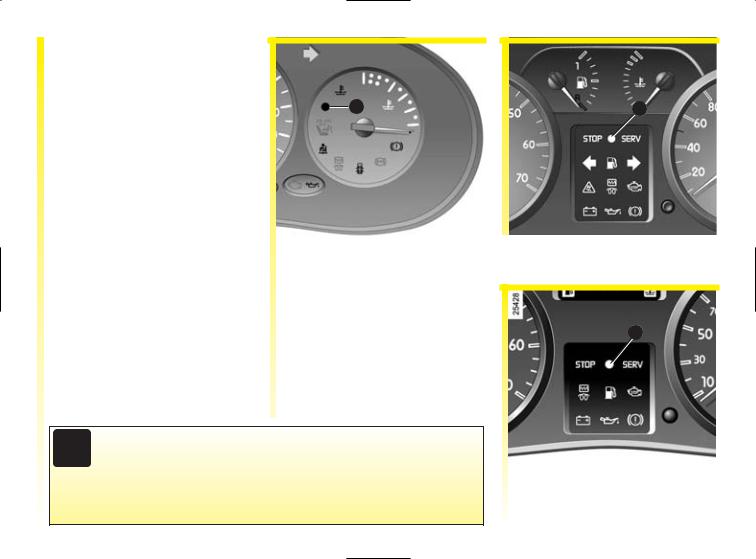
ENGINE IMMOBILISER
Immobiliser warning light ê
This prevents the vehicle
being driven by anyone not in possession of the vehicle’s coded ignition key.
Operating principle
The vehicle is automatically protected for a few seconds after the key is removed from the ignition.
If the vehicle does not recognise the ignition key code, warning light 1 will flash continuously and the engine cannot be started.
-System operational indicator light
When the ignition is switched on, warning light 1 comes on for approximately three seconds and then goes out. You can then start the engine. The vehicle has recognised the code and the engine can be started.
1
-Vehicle protection warning light
A few seconds after the ignition has been switched off, indicator light 1 will flash constantly.
The vehicle will not be protected until the key has been taken out of the ignition.
Any unauthorised work carried out on the engine immobiliser (computers, wiring, etc.) could be dangerous.
It must be carried out by a qualified RENAULT Technician.
1
1
1.15
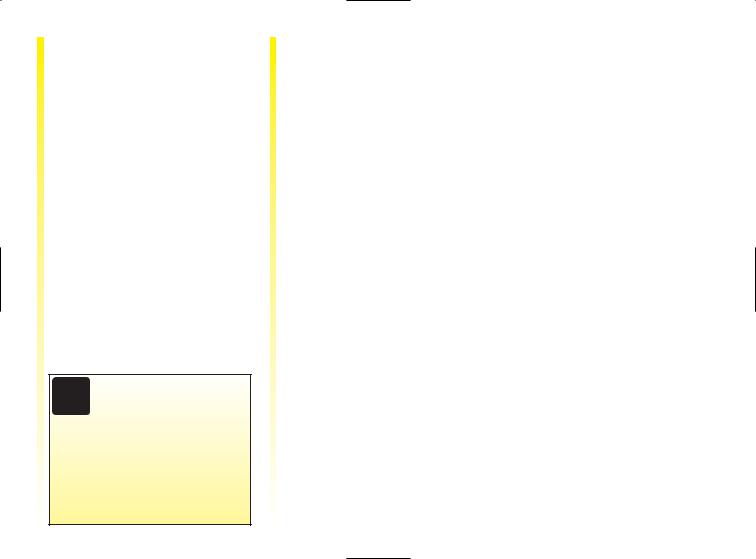
ENGINE IMMOBILISER SYSTEM (continued)
-Operating fault warning light Petrol version
After the ignition has been switched on, if warning light 1 continues to flash or remains continuously lit, this indicates a system operating fault.
Any unauthorised work carried out on the engine immobiliser (computers, wiring, etc.) could be
dangerous.
It must be carried out by a qualified RENAULT Technician.
Diesel version
If indicator light 1 comes on or remains lit after the ignition has been switched on, this indicates that the system is not operating correctly.
In all cases, it is essential to contact a RENAULT Dealer. Only RENAULT Dealers are qualified to repair the engine immobiliser.
If the coded ignition key is faulty, use the second key (supplied with the vehicle), when warning light 1 begins to flash quickly after the ignition has been switched on. If you do not have access to this, it is essential to contact a RENAULT Dealer. Only RENAULT Dealers are authorised to repair the engine immobiliser system.
1.16
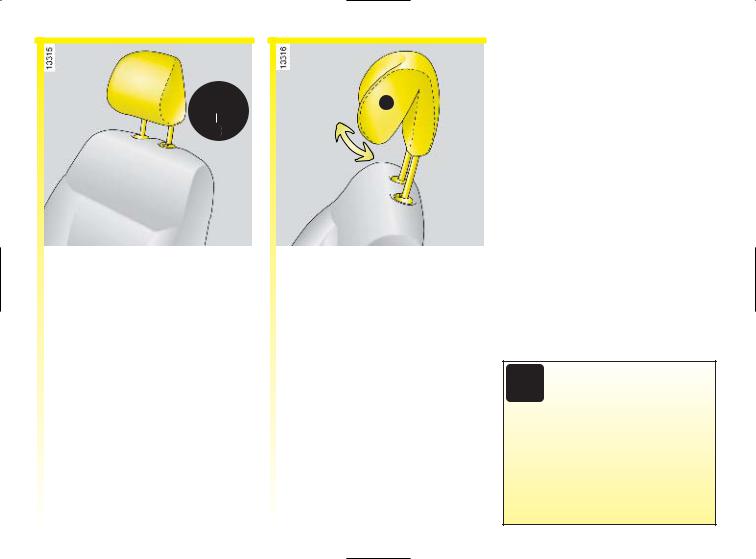
FRONT HEADRESTS
A
 1
1
To raise or lower the headrest
Pull the headrest towards you (i.e. towards the front of the vehicle) and slide it up or down at the same time.
To remove the headrest
First incline the seatback towards the rear.
Raise the headrest until it is at the highest possible setting. Lift up tab 1 and then pull the headrest upwards until it is released.
To refit the headrest
Insert the rods into the sleeves, with the notches facing the front.
Lower the headrest until it locks in position.
To adjust the angle of the headrest
On certain vehicles the angle of the headrest can be adjusted. To do this, move the front section A of the headrest forwards or backwards until it feels comfortable.
The headrest is important  for safety. Ensure that it is in place and in the correct position. The distance between your head and the headrest should be as small as possible. The top of your head should be in line with the top of the
for safety. Ensure that it is in place and in the correct position. The distance between your head and the headrest should be as small as possible. The top of your head should be in line with the top of the
headrest.
1.17
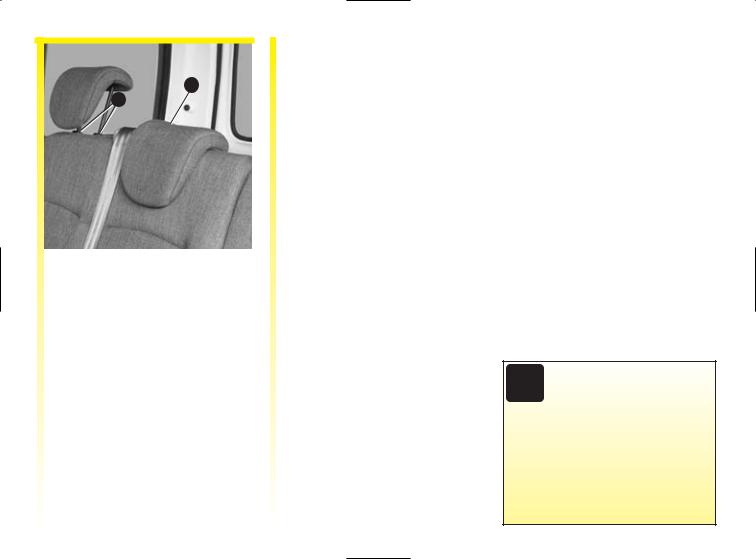
REAR HEADREST
2
1
To raise it
Simply slide it up.
To lower it
Press tabs 1 (on the headrest guide) while pushing it down at the same time.
To remove it
Fit the headrest and then press tabs 1 to release it.
To refit the headrest
Insert the rods into the sleeves, with the notches to the front, and lower the headrest to the desired height by pressing tab A.
Storage position 2
Press the headrest guide tabs 1 and lower the headrest completely.
When the headrest is fully lowered, it is in the storage position; do not use this position when someone is sitting in the rear seats.
The headrest is important  for safety. Ensure that it is in place and in the correct position. The distance between your head and the headrest should be as small as possible. The top of your head should be in line with the top of the
for safety. Ensure that it is in place and in the correct position. The distance between your head and the headrest should be as small as possible. The top of your head should be in line with the top of the
headrest.
1.18
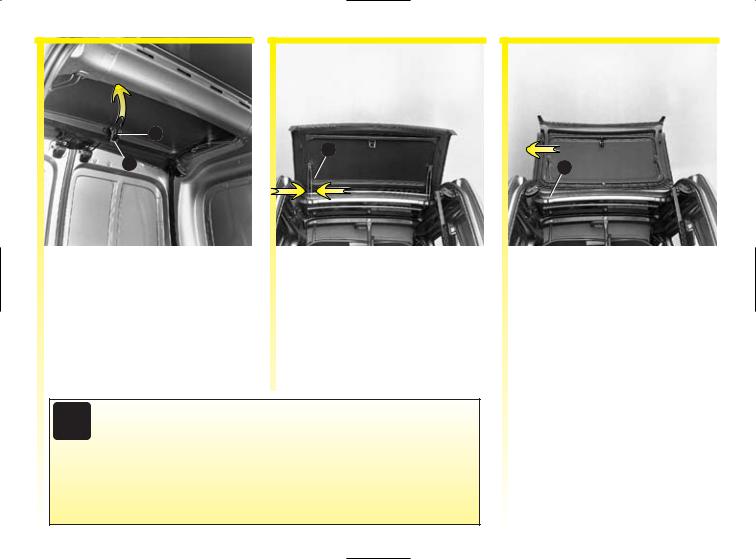
ROOF FLAP
1
3
2 |
4 |
To open
-Unfasten clip 2 by moving catch 1 upwards.
-Lift the flap until it is locked in position.
Closing
Close the roof flap before you close the rear doors.
To remove
-Press the two rods 3 towards each other on each side.
-Unhook them from their mounting.
Driving with the roof flap open may be unpleasant for passengers because exhaust gas may enter the passenger compartment. This use is solely for short distances whilst transporting bulky objects without having to open the rear doors. In this case, close the
windows and operate the ventilation system at the half or fully open setting as this will help to prevent exhaust gas from entering the passenger compartment.
-Hold the flap with both hands.
-Tilt it as far as possible to the rear and release it from hinges 4 in the direction of the arrow.
1.19
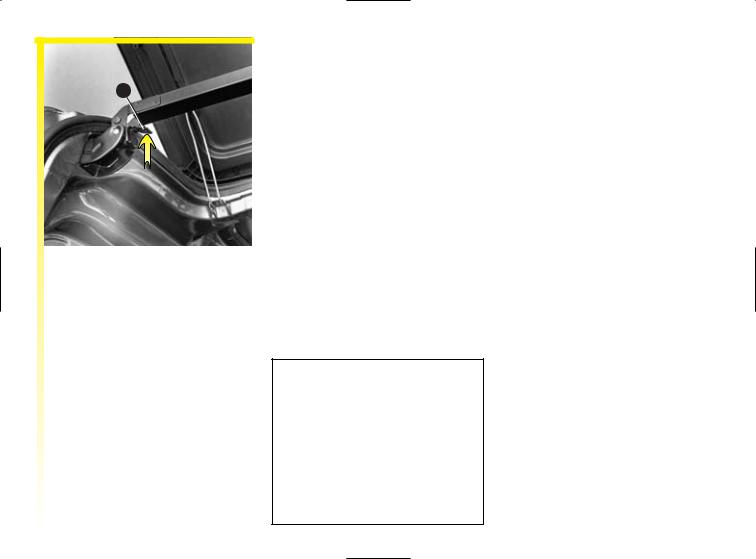
ROOF FLAP (continued)
5
Transverse bar
When loading bulky objects, the transverse bar may be moved:
-Press handle 5 upwards.
-Lift the bar all the way to the door pillar.
-Reposition the bar after loading.
Before starting off, always reposition the transverse bar.
The rear doors can only be closed with the bar locked.
Remember that the overall vehicle dimensions may change when you are transporting bulky objects.
1.20
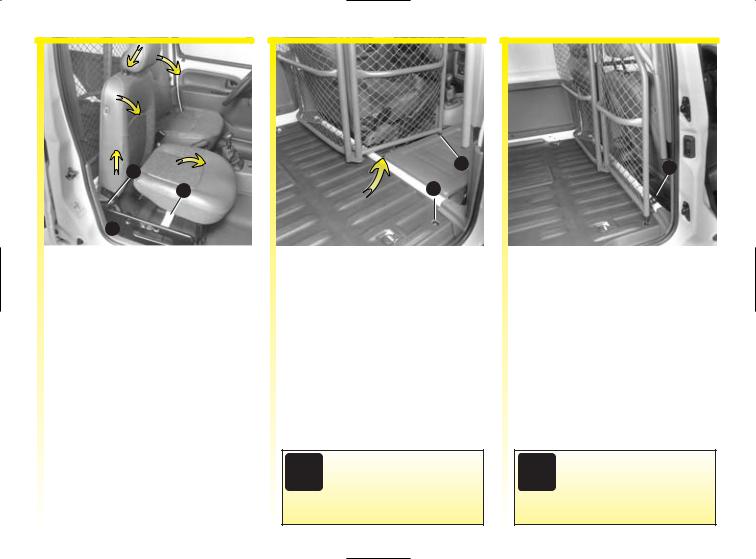
PARTITION
1
3
2
Using the swivelling bulkhead
-Bring the front passenger seat base into a vertical position by pulling it past the point of resistance (arrow).
-Unlock the seatback by raising the handle 1 and push it into a horizontal position after lowering the headrest. Press the top of the headrest to make the operation easier. It is hinged.
Label 2 reminds you of these instructions.
4 |
6 |
5
-Release the swivelling section by lifting catch 6 until it locks in position.
-Pivot the moving section until it is at right angles and lock it at point 4 by lowering catch 6.
Follow the safety instructions on label 3.
Note: before returning the swivelling section to its original position, make sure that locking point 5 is not obstructed.
The swivelling bulkhead section must always be locked when the vehicle is driven.
1.21
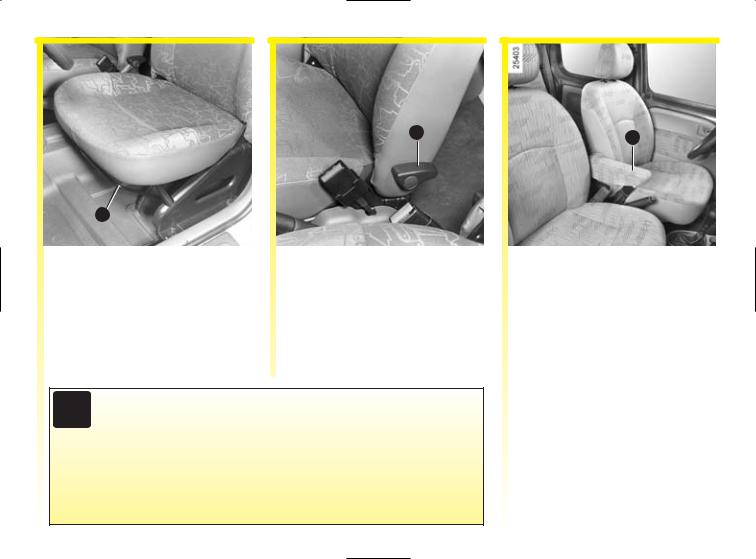
FRONT SEATS
1
To move a seat forwards or backwards
Stay in your seat and raise bar 1 to unlock the mechanism.
2
To tilt the seatback
Move lever 2 until the seatback is at the desired angle.
We would advise you not to recline the seatbacks too far back to ensure that the effectiveness of the seat belts is not reduced.
Make sure that the seatback is locked in place correctly.
No objects should be placed on the floor (area in front of driver) as these objects could slide under the pedals during braking manoeuvres, thus obstructing its use.
3
ðHeated seats
With the ignition on, press the switch located on the side of the seat base. An indicator light will come on. The system has a thermostat and determines whether or not heating is necessary.
Front armrest 3
1.22
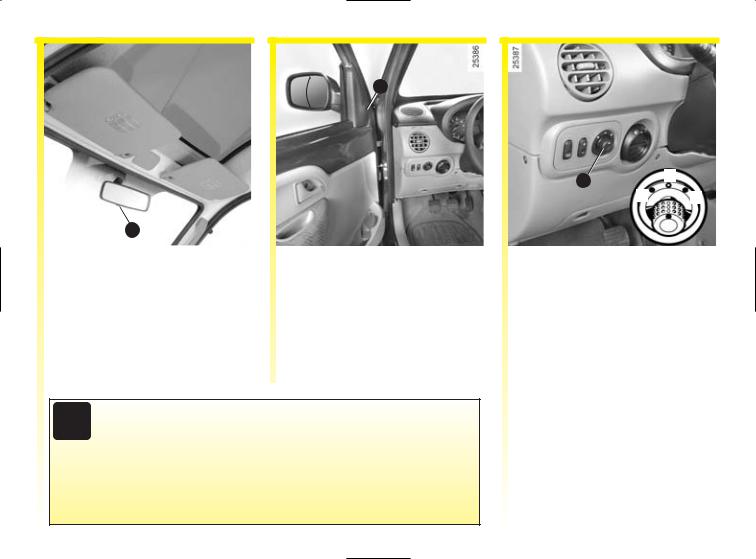
REAR-VIEW MIRRORS
1 |
Interior rear-view mirror
The interior rear-view mirror is adjustable. When driving at night, tilt small lever 1 to avoid being dazzled by the headlights of the vehicle behind.
A B |
2 |
Door mirror
To adjust the mirror, move lever 2.
On some models, the door mirror has two clearly defined zones. Zone B is what can normally be seen in a conventional door mirror. For your safety, zone A increases rear side visibility.
The objects in zone A look much further away than they really are.
3 |
A |
B |
C |
Electrically-adjustable door mirrors
With the ignition on, turn knob 3:
-position B to adjust the left-hand door mirror;
-position C to adjust the right-hand door mirror;
A is the neutral central position.
Heated door mirrors
The door mirrors are also de-iced when rear screen demisting is switched on.
1.23

SEAT BELTS
Always wear your seat belt when travelling in your vehicle. You must also comply with the legislation of the particular country you are in.
Before starting:
-first ensure that your driving position is correct,
-then adjust your seat belt to provide maximum protection.
Incorrectly adjusted seat belts may cause injuries in the event of an
accident.
Even pregnant women should wear a seat belt. In this case, ensure that the lap belt is not exerting too much pressure on the abdomen but do not allow any slack.
Adjusting your driving position
-Sit with your back firmly against the seatback. (after having removed your coat or jacket).
This is essential to ensure that your back is in the correct position.
-Adjust the distance between the seat and the pedals.
Your seat should be as far back as possible while still allowing you to fully depress the clutch pedal. The seatback should be adjusted so that your arms are slightly bent when you hold the steering wheel.
-Adjust the position of your headrest.
For safety reasons, the top of the headrest must be level with the top of the head.
1
2
Adjusting the seat belts
Sit with your back firmly against the seatback.
The shoulder strap 1 should be as close to the base of your neck as possible but not on it.
The lap strap 2 should be worn flat over your thighs and against your pelvis.
The belt should be worn so that it is as close to your body as possible, i.e. avoid wearing heavy clothing, having bulky objects under the belts or reclining the seatback excessively, etc.
1.24
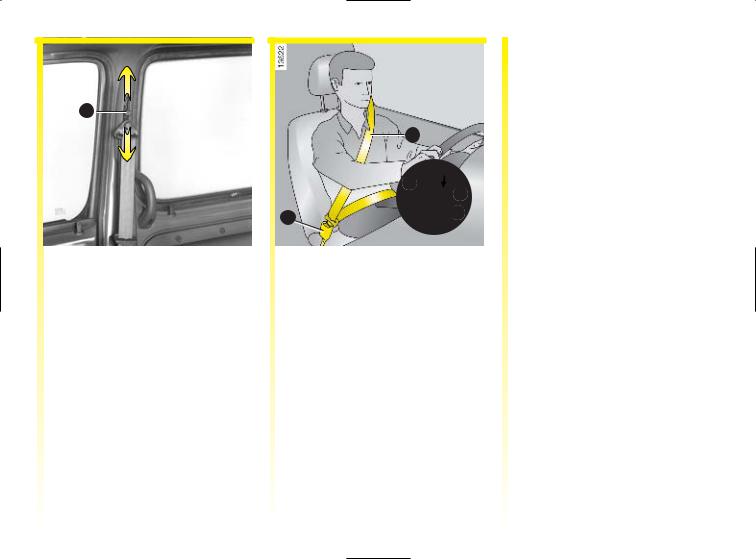
SEAT BELTS (continued)
3
Adjusting the front seat belt height
Press button 1 to select the adjustment position you require so that shoulder strap 3 is worn as described above.
Make sure that the seat belt is locked in position correctly after you have adjusted it.
1
5
6
4 |
4 |
|
Locking
Unwind the belt slowly and smoothly and ensure that buckle 5 locks into housing 4 (check that it is locked by pulling buckle 5). If the belt jams, allow it to run back before attempting to unwind it again.
To fasten (continued)
If your belt becomes completely jammed:
-pull the belt slowly but firmly so that just over an inch (3 cm) unwinds;
-then allow the belt to rewind automatically,
-unwind it again,
-if there is still a problem, contact your RENAULT Dealer.
çDriver’s seat belt reminder warning light
This lights up constantly, and, when the vehicle reaches a speed of approximately 6 mph (10 km/h), depending on the vehicle, it will flash and a beep will sound for approximately 90 seconds before the light returns to being constantly lit.
Unlocking
Press button 6 on buckle 4 and the seat belt will be rewound by the inertia reel.
Guide the buckle to help the operation.
1.25
